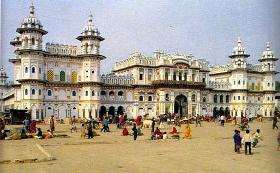
Temples of Nepal
Nepal has several ancient pilgrimage sites. Each temple is attached to a legend or belief that glorifies the miraculous powers of its deity. Kathmandu Valley is home to the famous Pashupatinath Temple, Swayambhu Stupa and several other famous temples. Hundreds of famous temples are located in and around the Kathmandu Valley.Some well-known pilgramage sites are: Barah Chhetra, Halesi Mahadev, Janakpur, Pathibhara, Tengboche in East Nepal; Manakaman, Gorkha, Lumbini, Muktinath, Gosainkunda, Tansen, Kathmandu Valley in Central Nepal; and Swargadwari, Khaptad Ashram in West Nepal.
Pashupatinath Temple
The Pashupatinath Temple is the largest Hindu temple and is considered to be the holiest of all Hindu Temples. This is a two-tiered golden temple with four silver doorways, hundreds of Shiva linga's shrines and holy symbols. It is located on the holy river - Bagmati, 6 km east of Kathmandu. Non- Hindus are not allowed into this temple.
It is believed that this temple was built long before the Christian era begin. Its original beauty still remains with the beautifully sculpted stone sculptures found here. Thousands of Hindus come each year on Shivaratri.
Janaki Temple
Dedicated to Sita, the Janaki Mandir located at Janakpur is traditionally held to stand on the spot where King Janak came across the baby in a furrow in a field. Despite its imposing size the temple comes into view somewhat unexpectedly, being approached via a narrow, twisting alleyway.
The mandir was built in 1911 by a local princess at the cost, it is said, of nine lakhs (Rs 900,000). Both the overall appearance and architectural detail of the temple are Islamic in influence, the dome in particular being reminiscent of a Rajasthani palace.
The silver doors to the interior of the shrine are opened daily from 5-7am and 6-8pm when the flower-bedecked statue of Sita, reputed to have been found in the River Sarya near Ayodyha, can be viewed. Beside her are figures of Rama and his half-brothers Lakshman, Bharat and Satrughna.